Galleria Borghese
The Galleria Borghese (Italian for 'Borghese Gallery') is an art gallery in Rome, Italy, housed in the former Villa Borghese Pinciana. At the outset, the gallery building was integrated with its gardens, but nowadays the Villa Borghese gardens are considered a separate tourist attraction. The Galleria Borghese houses a substantial part of the Borghese Collection of paintings, sculpture and antiquities, begun by Cardinal Scipione Borghese, the nephew of Pope Paul V (reign 1605–1621). The building was constructed by the architect Flaminio Ponzio, developing sketches by Scipione Borghese himself, who used it as a villa suburbana, a country villa at the edge of Rome.
 | |
 Location of the museum in Rome | |
| Established | 1903 |
|---|---|
| Location | Villa Borghese, Rome, Italy |
| Coordinates | |
| Type | Art museum |
| Director | Francesca Cappelletti[1] |
| Website | galleriaborghese |
Scipione Borghese was an early patron of Bernini and an avid collector of works by Caravaggio, who is well represented in the collection by his Boy with a Basket of Fruit, St Jerome Writing, Sick Bacchus and others. Additional paintings of note include Titian's Sacred and Profane Love, Raphael's Entombment of Christ and works by Peter Paul Rubens and Federico Barocci.
History
The Casino Borghese was erected an area that in the seventeenth-century was outside of the walls of Rome, with the closest access being the Porta del Popolo. At the origins, the villa grounds covered an area with a circumference of nearly 3 miles.[2] The main building was designed by the Flemish architect Giovanni Vasanzio. The portico had spolia derived from the Arch of Claudius, once on the Via Flaminia.[3]
By 1644, John Evelyn described it as "an Elysium of delight" with "Fountains of sundry inventions, Groves and small Rivulets of Water". Evelyn also described the Vivarium that housed ostriches, peacocks, swans and cranes "and divers strange Beasts". Prince Marcantonio IV Borghese (1730–1800), who began the recasting of the park's formal garden architecture into an English landscape garden, also set out about 1775, under the guidance of the architect Antonio Asprucci, to replace the now-outdated tapestry and leather hangings and renovate the Casina, restaging the Borghese sculptures and antiquities in a thematic new ordering that celebrated the Borghese position in Rome. The rehabilitation of the much-visited villa as a genuinely public museum in the late eighteenth century was the subject of an exhibition at the Getty Research Institute, Los Angeles, in 2000,[4] spurred by the Getty's acquisition of fifty-four drawings related to the project.
In 1808, Prince Camillo Borghese, Napoleon's brother-in-law,[5] was forced to sell the Borghese Roman sculptures and antiquities to the Emperor. The result is that the Borghese Gladiator, renowned since the 1620s as the most admired single sculpture in Villa Borghese, must now be appreciated in the Musée du Louvre. The "Borghese Hermaphroditus" is also now in the Louvre.
The Borghese villa was modified and extended down the years, eventually being sold to the Italian government in 1902, along with the entire Borghese estate and surrounding gardens and parkland.
Collection
.jpg.webp)
The Galleria Borghese includes twenty rooms across two floors.
The main floor is mostly devoted to classical antiquities of the 1st–3rd centuries AD (including a famous 320–30 AD mosaic of gladiators found on the Borghese estate at Torrenova, on the Via Casilina outside Rome, in 1834), and classical and neo-classical sculpture such as the Venus Victrix.
The main floor's main large room, called the Salone, has a large trompe-l'œil ceiling fresco in the first room by the Sicilian artist Mariano Rossi makes such good use of foreshortening that it appears almost three-dimensional. The fresco depicts Marcus Furius Camillus relieving the siege of the Capitoline Hill by the Gauls. The grotteschi decorations were painted by Pietro Rotari, and the animal decorations by Venceslaus Peter Boemo.[6]
The first room off the Salone, is the Camera di Cerere, with marble vase depicting Oedipus and the Sphinx. The second room has a ceiling frescoed by Francesco Caccianiga with the Fall of Phaeton. The third room houses Bernini's Apollo and Daphne.[7]
Gian Lorenzo Bernini at the Borghese
Many of the sculptures are displayed in the spaces for which they were intended, including many works by Gian Lorenzo Bernini, which comprise a significant percentage of his output of secular sculpture, starting with early works such as the Goat Amalthea with Infant Jupiter and Faun (1615) and Aeneas, Anchises & Ascanius (1618–19) [8][9] to his dynamic Rape of Proserpine (1621–22), Apollo and Daphne (1622–25) [10] and David (1623) [11] which are considered seminal works of baroque sculpture. In addition, several portrait busts are included in the gallery, including one of Pope Paul V, and two portraits of one of his early patrons, Cardinal Scipione Borghese (1632).[12] The second Scipione Borghese portrait was produced after a large crack was discovered in the marble of the first version during its creation.
Nearby museums
Also in Villa Borghese gardens or nearby are the Galleria Nazionale d'Arte Moderna, which specialises in 19th- and 20th-century Italian art, and Museo Nazionale Etrusco, a collection of pre-Roman objects, mostly Etruscan, excavated around Rome.
Gallery
Sculptures
 Truth Unveiled by Time by Bernini. c. 1645-1652
Truth Unveiled by Time by Bernini. c. 1645-1652 Apollo and Daphne by Bernini. c. 1622
Apollo and Daphne by Bernini. c. 1622 Rape of Proserpine by Bernini. c. 1621
Rape of Proserpine by Bernini. c. 1621 David by Bernini. c. 1623-1624
David by Bernini. c. 1623-1624.jpg.webp) Pauline Bonaparte by Antonio Canova.
Pauline Bonaparte by Antonio Canova. Bust of Scipione Borghese by Bernini. c. 1632
Bust of Scipione Borghese by Bernini. c. 1632
Paintings
 Melissa by Dosso Dossi. c. 1507
Melissa by Dosso Dossi. c. 1507 Saint Jerome Writing by Caravaggio. c. 1606
Saint Jerome Writing by Caravaggio. c. 1606 The Deposition by Raphael. c. 1507
The Deposition by Raphael. c. 1507 St John the Baptist by Caravaggio. c. 1610
St John the Baptist by Caravaggio. c. 1610 The Last Supper by Jacopo Bassano. c. 1546
The Last Supper by Jacopo Bassano. c. 1546.jpg.webp) Madonna, Child and Serpent by Caravaggio. c. 1605-1606
Madonna, Child and Serpent by Caravaggio. c. 1605-1606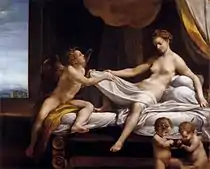 Danaë by Correggio. c. 1530
Danaë by Correggio. c. 1530 Boy with a Basket of Fruit by Caravaggio. c. 1593
Boy with a Basket of Fruit by Caravaggio. c. 1593 Diana and Her Nymphs by Domenichino. c. 1616-1617
Diana and Her Nymphs by Domenichino. c. 1616-1617 The Scourging of Christ by Titian. c. 1560
The Scourging of Christ by Titian. c. 1560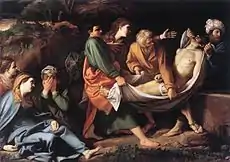 Deposition by Sisto Badalocchio. c. 1610
Deposition by Sisto Badalocchio. c. 1610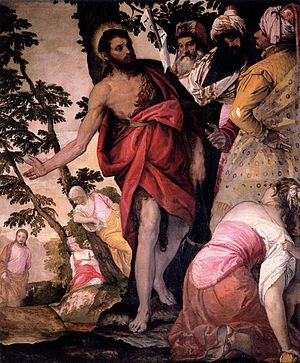 St John the Baptist by Paolo Veronese. c. 1562
St John the Baptist by Paolo Veronese. c. 1562 Deposition by Peter Paul Rubens. c. 1602
Deposition by Peter Paul Rubens. c. 1602 The Concert by Gerrit van Honthorst. c. 1626-1630
The Concert by Gerrit van Honthorst. c. 1626-1630 Portrait of a Man by Antonello da Messina. c. 1474-1475
Portrait of a Man by Antonello da Messina. c. 1474-1475 Lady with a Unicorn by Raphael. c. 1505
Lady with a Unicorn by Raphael. c. 1505 Venus Blindfolding Cupid by Titian. c. 1565
Venus Blindfolding Cupid by Titian. c. 1565 St. Dominic by Titian. c. 1565
St. Dominic by Titian. c. 1565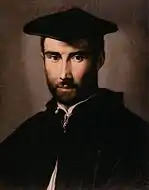 Portrait of a Man by Parmigianino. c. 1528
Portrait of a Man by Parmigianino. c. 1528 Madonna and Child and Saints by Lorenzo Lotto. c. 1508
Madonna and Child and Saints by Lorenzo Lotto. c. 1508 Susanna and The Elders by Peter Paul Rubens. c. 1607-1608
Susanna and The Elders by Peter Paul Rubens. c. 1607-1608 Madonna and Child by Giovanni Bellini. c. 1510
Madonna and Child by Giovanni Bellini. c. 1510 Young Sick Bacchus by Caravaggio. c. 1593
Young Sick Bacchus by Caravaggio. c. 1593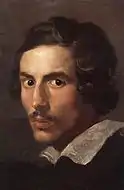 Self Portrait by Gian Lorenzo Bernini. c. 1623
Self Portrait by Gian Lorenzo Bernini. c. 1623
Notes
- Brown, Kate (17 November 2020), "The New Director of Rome's Famed Galleria Borghese Plans to Take the Museum in a 'More Contemporary Direction.' Here's How", artnet, retrieved 19 November 2020
- Guida metodica di Roma e suoi contorni, by Giuseppe Melchiorri, Rome (1836); page 609.
- Melchiorri, page 610.
- Making a Prince's Museum: Drawings for the Late Eighteenth-Century Redecoration of the Villa Borghese. Getty Research Institute (17 June-17 September 2000). Catalogue by Carole Paul, with an essay by Alberta Campitelli. ISBN 978-0-89236-539-5
- He had married Pauline Bonaparte; Antonio Canova's half-nude portrait of her as Venus Victrix takes pride of place in one of the galleries.
- Melchiorri, pages 610–611.
- Melchiorri, page 611.
- Web Gallery of Art, image collection, virtual museum, searchable database of European fine arts (1100–1850)
- Web Gallery of Art, image collection, virtual museum, searchable database of European fine arts (1100–1850)
- Apollo and Daphne by BERNINI, Gian Lorenzo Archived 2005-11-15 at the Wayback Machine
- Web Gallery of Art, image collection, virtual museum, searchable database of European fine arts (1100–1850)
- Bust of Scipione Borghese by BERNINI, Gian Lorenzo
External links
| Wikimedia Commons has media related to Museo e Galleria Borghese. |
- Official website
- Amor sacro e amor profano (Sacred and Profane Love) Description of the painting.
- Architecture and gardens on the Villa Borghese or Casino
- Reviews of Galleria Borghese
- Satellite photo — the Galleria Borghese is the villa in the center of the photograph surrounded by landscaped gardens.
- Roman Map of the area with related services